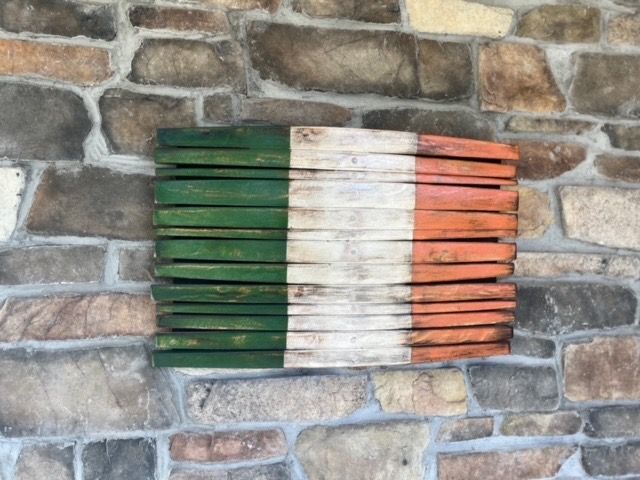Maura Mulligan giving a short lesson on learning some Irish by means of the song, "An Caitlin Alainn."
By Deirdre Batson
A far more enjoyable harbinger of spring than groundhog behavior was evident in a gathering of the New York Irish community on Sunday Feb. 3 at the Ripley-Grier studios in Midtown Manhattan. St. Brigid’s Day, technically Feb. 1, was and still is in some parts of Ireland, Scotland and the Isle of Man, a much-anticipated celebration. Known in the Celtic calendar as the first of four seasonal “fire festivals” of the year, Imbolg, as it is otherwise known, is referred to in early Irish literature and has recently enjoyed a cultural revival. The event is enjoyed with music, dance, crafts and food as a favorite figure of Brigid, a saint and also a druidic goddess, is revered for her association with new birth, fertility, water and fishermen, immigrants and dairy farmers, scholars and many other attributes particularly evident at this time of the year. Committed from an early age to help the poor, she and a group of women followers built both a convent and a monastery in Kildare, which became famous as a cultural and learning destination. Brigid herself became the most powerful woman in 5th century Ireland.
A creative and committed group of women in New York, Nollaig Na mBan NY planned and participated in this gathering, as well as organizing a roster of participants for the festivals of Beltane (May 1), Lughnasa (Aug. 1), and Samhain (Oct. 31). Nollaig Na mBan, or Women’s Christmas, is an old Irish custom celebrated on Jan. 6. It was a time for women to take a break from household chores and let the men take over the cooking and cleaning for a day. In modern times it has become a day to celebrate the creativity of women and to organize events to raise funds for research particularly into women’s issues like breast cancer research. Nollaig Na mBan NY was formed during a 2015 Women’s Day celebration. Musicians, poets, writers, dancers and storytellers donate their impressive talents and time to regale the audience with performance and with teaching some relevant arts. The proceeds from a modest door donation are given to the Dwelling Place, a transitional shelter for homeless women on Manhattan’s West Side. Established in 1977 by the Franciscan Sisters of Allegheny, this organization provides support and help in finding permanent housing and employment and has been the inspiration for these fundraising efforts. The administrator, Sr. Joann Sambs, is always present for each festival, sometimes participating, but on this occasion she was recovering from knee surgery, so instead sent a warm and eloquent written ‘thank you’ to everyone present.

Your columnist, Deirdre Batson, leading a weaving class.
On this spring weather-like Sunday, the festivities began with a lively combination of fiddle, guitar and song by the marvelous Mary Courtney and Vonnie Quinn. Karen Daly, one of the Nollaig Na mBan members, introduced each performance with her signature spot-on bios and humor. Karen suggested we check out Courtney’s website for details of upcoming gigs, as well as her latest CD “Freedom’s Pioneers.” Next up was a short play, “Brigid,” written by Nollaig Na mBan’s Maura Mulligan. Created as an instructional device but with plenty of opportunity to expand into a true dramatic piece, the play imagines the meeting of the two Brigids – pagan goddess (played by Nancy Oda) and Christian saint (Dee Nolan). The resulting conversation informs and, at the same time, establishes, the separate identities of these remarkable women. With humor and warmth, plus some jostling for position and appreciation by the modern world, the audience better understands the contributions each Brigid had made, both separately and together, to create an enduring legend. Saint Brigid was born and raised in a Druidic household, later converting to Christianity. The play reminds us of the struggle for acceptance of pagan rituals into Christianity where the ‘magic’ wrought by gods and goddesses has been explained as God’s will. The play was beautifully bookended by the chanting of the liturgical prayer to St Brigid sung by Vera Wrenn. (See Doris Marie Meyer's short review at the end of this report).
After a refreshment break of wine, cheeses, fruit and Mary Fee’s delicious Irish soda bread, Maura Mulligan sang a beautiful short poem about the coming of spring, written in Irish by the blind poet and musician Antoine O Raifteiri who was born in 1799 a few miles from Maura’s birthplace. The audience was then treated to a short lesson on learning some Irish through a simple song, “An Cailin Alainn” – meaning the “beautiful girl.” Encouraged by Maura, a New York City teacher for many years, to use our ears to learn the words and melody, the resulting three verses eventually sounded pretty good. We all got to hear the words as lilting cadence, even if it wasn’t easy to wrap our own tongues around them!
As a relaxing way to wind down, Dee Nolan and I piloted a simple craft activity – making a St Brigid’s Cross. Traditionally done with rushes, they brought instead an array of pipe cleaners and showed our eager participants the best way to fashion the traditional shape. We could be very creative in the choice of colors, and some of us were unintentionally creative in the final shape of the central cross, but both teachers and students came away with a very special keepsake from a very special celebration! A special “thank you” to Dan Brown who comes to every performance and takes wonderful photographs that we can all enjoy.

Vonnie Quinn and Mary Courtney at the Imbolg/St. Brigid's Day Celebration.
As everyone took their leave that afternoon, clutching crosses, humming the melodies and with a new appreciation of this very special day, St Brigid would have been smiling broadly to witness this selection of performances and workshops in her honor.
Doris Marie Meyer, president of the American Irish Teachers Association and co-chair of the UFT Irish Studies Committee, has written this response on seeing the first performance of “Brigid” at the Ripley-Grier Studios:
“Maura Mulligan’s dramatization of the attributes shared by both Brigid the saint and Brigid the goddess would be well received by educators and their students. The richness of ancient Irish mythology is captured in the lines delivered by the pre-Christian Brigid as she reveals her powerful place in the pantheon of Celtic gods and goddesses.
“The play’s development of the character of St. Brigid as one who welcomes her ties to the goddess provides a better understanding of the hagiography about her. Of all the Celtic seasonal festivals, Imbolg is one that offers renewal in the promise of spring, and Maura’s play conveys how this offer is made by both the goddess and saint. For any student who may only know the story of St. Patrick, ‘Brigid’ is a fascinating way to learn about this other patron saint of Ireland and how she is tethered to the mythological world of the Tuatha de Danann.”










